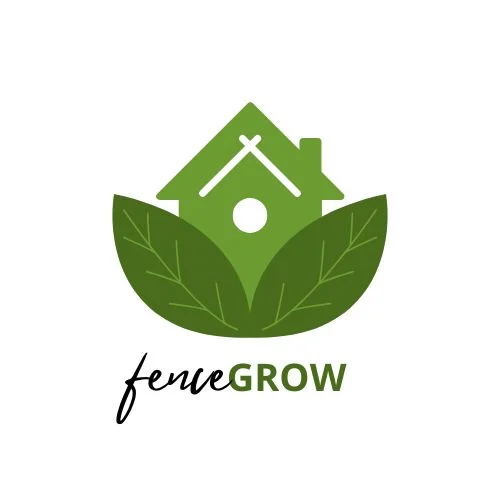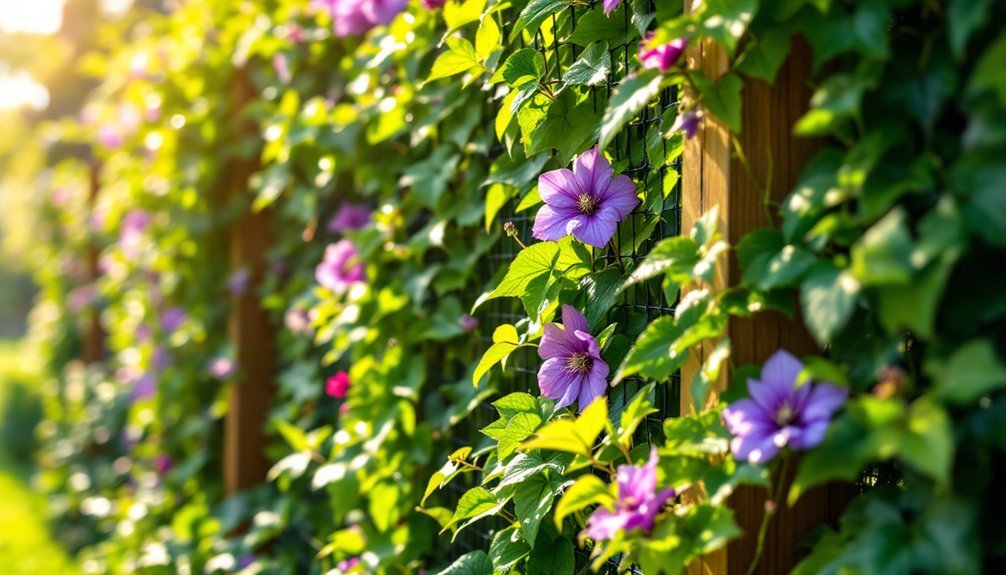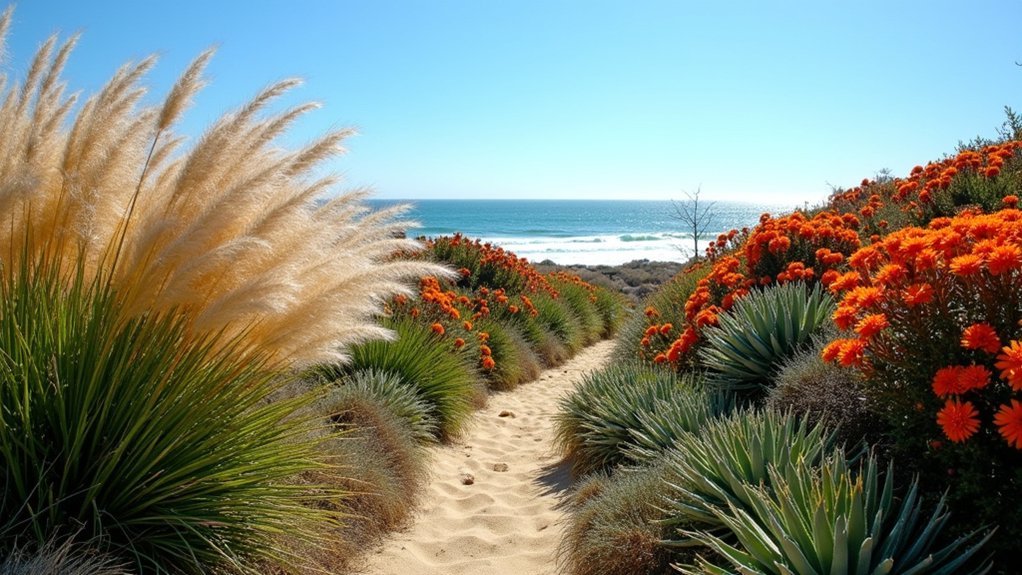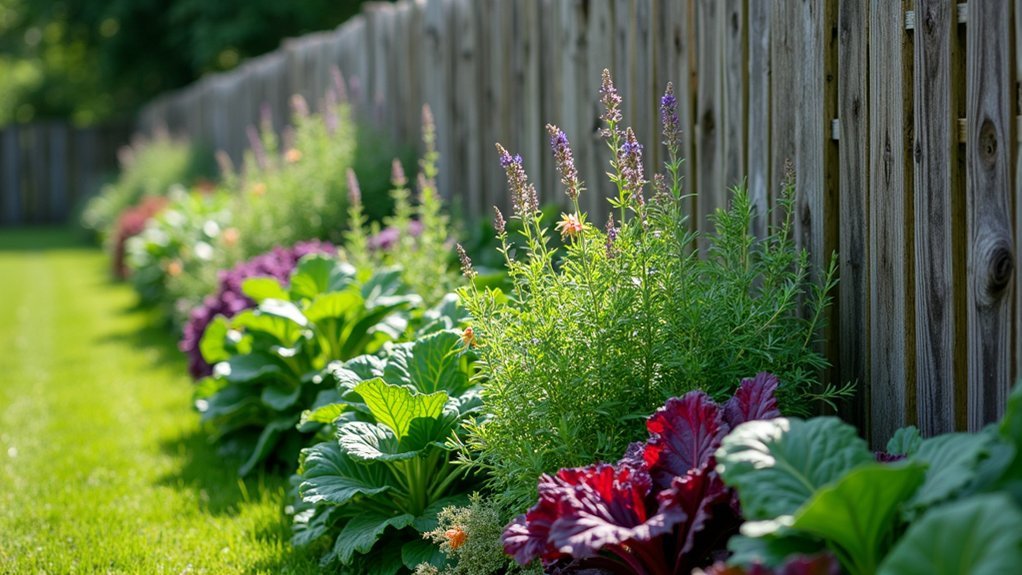You're planning to create that living fence you've always wanted, but finding the right vine support netting can be overwhelming. With countless options available, each offering different durability, materials, and aesthetics, how do you choose what's best for your climbing plants? Whether you're growing flowering vines, vegetables, or privacy screens, the perfect support system makes all the difference between a struggling display and a thriving green masterpiece. Let's explore the top options for 2025.
Plant Support Netting, Biodegradable Jute Net for Climbing Plants
Environmentally conscious gardeners who want to create a living fence will find the Wedhapy Biodegradable Jute Net an ideal solution. This light brown jute netting (79 x 197 inches) supports heavy crops like tomatoes and beans while remaining 100% compostable.
You'll appreciate how this versatile mesh promotes air circulation and sunlight exposure for healthier plant growth. It's perfect for training climbing roses, grapes, and cucumbers along your fence line. The generous dimensions allow you to customize the netting to fit your specific garden layout, while its natural aesthetic blends beautifully with your outdoor space.
Best For: Eco-conscious gardeners seeking a natural, biodegradable support solution for climbing plants, vine crops, and creating living green walls or decorative garden displays.
Pros:
- 100% biodegradable jute material makes it an environmentally friendly choice that will eventually compost back into the soil
- Generous 79 x 197 inch dimensions provide ample coverage for large garden projects while being easily customizable for smaller spaces
- Versatile application beyond plant support, including decorative mesh for fences, safety netting, and indoor photo display backdrops
Cons:
- At 11.9 ounces, the lightweight nature may require additional securing for supporting very heavy plant varieties
- Natural jute material will decompose over time, requiring replacement more frequently than synthetic alternatives
- Limited color option (light brown only) may not blend with all garden or home aesthetic preferences
Trellis Netting for Climbing Plants, CANAGROW Heavy-Duty Garden Net
CANAGROW's Heavy-Duty Garden Net stands out as the ideal choice for homeowners seeking to create living fences with minimal maintenance. Available in 6x15ft or 6x30ft options, this lightweight polyester-nylon blend can be easily cut to fit your specific garden requirements.
The 6×6-inch square mesh design allows you to access your plants while providing robust support for various climbers like tomatoes, beans, and flowering vines. At just 3.17 ounces, you'll find installation straightforward whether creating vertical, horizontal, or A-frame structures.
With a 4.3-star rating from nearly 1,500 customers, this reusable trellis netting offers durability and versatility for years of garden use.
Best For: Home gardeners looking to maximize vertical growing space for climbing vegetables and flowering vines while maintaining easy access to their plants.
Pros:
- Lightweight yet durable polyester-nylon construction that can be easily cut to custom dimensions for various garden setups
- Large 6×6-inch mesh squares provide ideal support while allowing hand access for harvesting and plant maintenance
- Versatile installation options for vertical, horizontal, or A-frame configurations to accommodate different garden layouts
Cons:
- May require initial time to untangle the netting when first unpacking as mentioned in some customer reviews
- Limited color options (only available in white) which might be visually distracting in some garden designs
- At 0.09 kilograms, may require additional support structures when used with heavier producing plants like pumpkins
Climbing Plant Support: Natural Jute Garden Netting and Trellis (70x70in)
Natural jute garden netting stands out as the eco-conscious choice for gardeners who value sustainability without sacrificing functionality. This 70×70-inch trellis features 6-inch mesh that provides reliable support for various climbing plants including cucumbers, tomatoes, beans, and roses.
You'll appreciate how easily you can customize this versatile support—simply cut it to your desired dimensions and secure it with string or landscape stakes. The durable jute material lasts several growing seasons before naturally biodegrading, allowing you to compost it along with plant residue when its usefulness ends.
OwnGrown's jute netting delivers both performance and environmental responsibility for your living fence project.
Best For: Environmentally-conscious gardeners seeking a natural, biodegradable support system for climbing vegetables and flowering plants that can be integrated into compost at the end of its lifecycle.
Pros:
- Made from 100% natural jute that biodegrades completely, eliminating plastic waste from your garden
- Versatile 70×70-inch size with 6-inch mesh accommodates various climbing plants including cucumbers, tomatoes, beans, and roses
- Easy to customize by cutting to size and securing with simple tools like string or landscape stakes
Cons:
- Less durable than synthetic alternatives, showing signs of decay after several seasons
- May require additional fastening methods to ensure stability throughout the growing season
- Six-inch mesh size might be too large for supporting very young plants or certain delicate climbing varieties
BetyBedy Heavy-Duty Polyester Plant Trellis Netting (5 x 15FT)
The BetyBedy Heavy-Duty Polyester Plant Trellis Netting stands out as an excellent choice for gardeners seeking robust support for heavier climbing plants in their living fence designs. This durable polyester netting measures 5 x 15 feet with 6×6 inch mesh squares, perfect for accommodating various climbing plants.
You'll appreciate its resilience against sun, wind, and rain, making it ideal for year-round outdoor use. The netting's flexibility allows for various installation methods—vertical, horizontal, or A-frame configurations—to suit your specific garden needs. It's particularly effective for supporting tomatoes, beans, cucumbers, and other heavy-yielding vines while preventing ground-rot and promoting healthier plant development.
Best For: Home gardeners looking to support heavy-yielding climbing vegetables and fruits like tomatoes, beans, peas, and cucumbers in various trellis configurations.
Pros:
- Heavy-duty polyester construction withstands environmental elements and supports substantial plant weight without breaking
- Versatile 6×6 inch mesh design accommodates different plant sizes and can be installed in vertical, horizontal, or A-frame configurations
- Safe for plants with no sharp edges, allowing for healthy growth while reducing ground-rot risks
Cons:
- May unravel if cut too close to the stitching, requiring careful trimming during installation
- At 5×15 feet, may require multiple units for larger garden applications
- Limited to one mesh size (6×6 inch squares), which might not be ideal for all plant varieties or growth stages
All-Weather Trellis Netting Mesh for Plant Garden Vine Growing
Homeowners seeking a versatile solution for their living fence will find the All-Weather Trellis Netting Mesh exceptionally practical. This 5ft x 15ft polyester mesh features a 6-inch grid pattern that's perfect for training climbing plants in various configurations.
You'll appreciate its impressive durability and breaking strength for supporting heavier vine crops. Installation is straightforward—simply wrap and tie it around stable structures using the included ties. For best results, secure the netting to the ground and stretch it properly to prevent sagging.
While it excels with most climbing plants, you might need additional support for particularly heavy vegetables like mature cucumbers.
Best For: Home gardeners with limited space who want to grow climbing plants vertically to maximize their garden yield while keeping produce clean and protected from ground contact.
Pros:
- Easy installation with included ties, requiring minimal tools or expertise to set up on existing structures
- Versatile 6-inch mesh design works for various plants including vines, vegetables, and flowers in different garden configurations
- Durable polyester material withstands weather exposure while being non-toxic and safe for family gardens
Cons:
- May sag under the weight of heavier vegetables like cucumbers without proper installation and additional support
- 5ft height might be insufficient for some tall-growing vines that require more vertical climbing space
- Some users report concerns about long-term durability over multiple growing seasons
Garden Nylon Mesh Plant Support Trellis Netting for Climbing Plants
Gardeners seeking lightweight yet durable support for their living fence projects will find the Garden Nylon Mesh Trellis Netting an excellent solution. At 5.9×11.8ft with 4×4 inch mesh, this Gardeningwill product offers versatile support for various climbing plants.
The polyethylene construction provides impressive heat and cold resistance while weighing just 6.4 ounces. You'll appreciate how easily it installs with four corner fixing points, and its green color blends seamlessly with your garden aesthetic.
With a 4.3-star rating from users who've successfully grown everything from cucumbers to decorative vines, this reusable netting delivers reliable performance year after year.
Best For: Home gardeners looking for an affordable, lightweight solution to support climbing vegetables, flowers, and vines in small to medium garden spaces.
Pros:
- Lightweight (6.4 ounces) and easy to install with just four corner fixing points, making setup quick and manageable for one person
- Versatile 5.9ft x 11.8ft size with 4×4 inch mesh accommodates various climbing plants from cucumbers and tomatoes to decorative vines
- Durable polyethylene material offers excellent resistance to weather conditions and can be reused for multiple growing seasons
Cons:
- At 10x10cm mesh size, may be too large for supporting smaller tendrils or delicate climbing plants in early growth stages
- Some users might find the 5.9ft x 11.8ft dimension limiting for larger garden installations or commercial applications
- May require additional securing methods beyond the four corner points for withstanding strong winds when supporting heavier plants
Deer Fence Netting, 7 x 100 Feet Protective Garden Net for Plants
For those seeking to create living fences with climbing plants, Feitore's Deer Fence Netting offers three compelling advantages: versatility, durability, and ease of installation.
At 7×100 feet with 3/4-inch mesh, this polypropylene netting provides ample coverage for your climbing vines while deterring wildlife. You'll appreciate how easily it cuts to size and attaches to posts with the included cable ties and nails.
While primarily marketed as protective fencing, many gardeners repurpose it as excellent vine support. Its tear-resistant construction withstands weather elements, making it ideal for long-term vine training projects.
Best For: Home gardeners looking to protect vegetables and fruit plants from deer, birds, and other wildlife while also seeking a supportive structure for climbing plants.
Pros:
- Versatile 7×100 foot coverage with 3/4-inch mesh size accommodates various garden protection and plant support needs
- Complete installation kit includes 10 nails and 50 cable ties for easy setup without requiring additional purchases
- Durable polypropylene material resists tearing, rust, and rot, ensuring multiple seasons of use
Cons:
- At 1.7 pounds, the thin material may require reinforcement or multiple layers for protection against determined larger animals
- Some users report the netting lacks visibility to animals, potentially causing wildlife to run into it
- Requires stakes or posts (not included) for proper installation as a standalone fence
Green Trellis Netting for Garden Plants and Climbing Vegetables
When creating a living fence with climbing plants, green trellis netting offers a practical solution that combines strength with flexibility. This 100ft x 4ft high-density polyethylene netting features 5.9-inch mesh squares, perfect for supporting climbing vegetables and ornamental vines.
You'll appreciate its UV resistance and durability in various weather conditions. With a 4.4-star rating from nearly 300 customers, it's proven reliable for guiding plants upward rather than letting them sprawl across your garden. For best results, secure one end first, stretch fully, then stake the opposite side using 4ft garden stakes to prevent slipping.
Best For: Home gardeners looking to maximize vertical space with climbing vegetables, fruits, and ornamental vines while creating an organized garden layout.
Pros:
- Generous 100ft x 4ft dimensions with 5.9-inch mesh squares provide ample support for various climbing plants
- Made from UV-resistant, high-density polyethylene that withstands different weather conditions for long-term durability
- Easy to install with simple staking method and can be cut to custom lengths for different garden layouts
Cons:
- May be challenging to untangle and reuse once plants have grown through it
- At 4ft height, might be too short for some taller climbing varieties without additional support
- Requires proper staking with 4ft garden stakes to prevent slipping, adding to overall setup complexity
Trellis Netting 5 x 350 ft Heavy Duty Polyester Plant Support for Climbing Plants
The Trellis Netting 5 x 350 ft Heavy Duty Polyester model stands out as an exceptional choice for homeowners creating living fences with climbing plants. This Aticca product features durable 6-inch mesh that effectively supports tomatoes, peas, beans, and decorative climbing flowers.
You'll appreciate its versatility—easily cut and wrapped around any support structure for both vertical and horizontal applications. The sun-resistant polyester material guarantees longevity while promoting healthier plants by improving sun exposure and elevating vegetation off the ground.
With a 4.8-star rating, customers consistently praise its sturdiness for supporting even heavy vegetables, making it ideal for transforming your property boundary into a thriving living fence.
Best For: Home gardeners looking to maximize vertical growing space with climbing vegetables, flowering vines, or creating living privacy screens along property boundaries.
Pros:
- Exceptional durability with heavy-duty polyester construction that supports even heavy vegetables like cucumber and zucchini
- Versatile 5 x 350 ft size that can be easily cut to fit various garden structures or applications
- Promotes healthier plant growth by improving sun exposure and elevating plants off the ground
Cons:
- Higher price point compared to lighter garden netting options
- 6-inch mesh size may be too large for supporting certain smaller climbing plants
- Requires additional support structures like posts or frames for proper installation
QueenBird Trellis Netting for Climbing Plants (5.9 x 16.4 Feet)
Among our top-rated support options, QueenBird Trellis Netting stands out for gardeners seeking robust vine support with maximum flexibility. At 5.9 x 16.4 feet, this green netting features 4-inch mesh squares perfect for climbing vegetables and flowering vines.
You'll appreciate the durability of its UV-stabilized HDPE and nylon construction, designed to withstand multiple growing seasons. Installation couldn't be simpler—attach it to walls, fences, or frames using staples or screws, and cut to size with scissors.
With a 4.5-star rating from over 900 customers, this lightweight yet sturdy option delivers reliable performance for your vertical gardening projects.
Best For: Home gardeners with limited space who need reliable support for climbing vegetables like cucumbers, beans, and peas, or flowering vines such as morning glories and clematis.
Pros:
- Made from UV-stabilized HDPE and nylon for multi-season durability in various weather conditions
- Large 5.9 x 16.4 feet coverage with 4-inch mesh squares provides ideal support for climbing plants
- Easy to install and customize with scissors, attaching to various structures with staples or screws
Cons:
- Some users report difficulties with unraveling the netting during initial setup
- At 8.1 ounces, it may require additional reinforcement for extremely heavy fruits like melons
- Manufactured in China, which may concern shoppers looking for domestically produced garden supplies
Factors to Consider When Choosing Vine Support Netting for Living Fence Establishment
When selecting vine support netting for your living fence, you'll need to evaluate material durability and weight capacity to guarantee long-term stability as plants mature. The mesh size you choose directly affects how well your vines can grip and climb, while environmental sustainability considerations might lead you toward biodegradable or recycled options. Installation complexity varies widely between products, so factor in your available time and tools before making your final decision.
Material Durability
Selecting support netting with appropriate durability guarantees your living fence thrives for years without costly replacements. Heavy-duty polyester and nylon options offer superior strength and weather resistance—ideal investments for permanent living fence installations.
While biodegradable jute netting provides an eco-friendly alternative, expect replacement every few growing seasons as these materials naturally decompose. Consider mesh design carefully: tightly woven patterns with smaller holes typically withstand heavy vine growth better than wider-spaced alternatives that may stretch under weight.
For maximum longevity, choose UV-stabilized polyethylene netting, which resists sun damage even in harsh conditions. Check breaking strength specifications to ascertain your selected netting can support your chosen vines' mature weight without sagging or tearing, particularly important for aggressive climbing species that create substantial biomass over time.
Weight Capacity
Successful living fences demand support netting that won't buckle under pressure as vines mature and expand. When selecting your support system, prioritize heavy-duty options made from high-density polyethylene or polyester for substantial crops like tomatoes and cucumbers.
Look for netting with a mesh size of 6×6 inches or smaller, which offers ideal support while maintaining essential airflow and sunlight penetration for healthy plant development. Your installation method greatly impacts weight-bearing capacity—secure the netting firmly to stable structures to prevent sagging and collapse as plants reach maturity.
Don't overlook the importance of regular maintenance. Inspect your netting frequently for signs of wear, particularly after severe weather events. Even the strongest materials deteriorate over time, potentially compromising their ability to support your living fence's increasing weight.
Mesh Size Impact
The right mesh size serves as an essential foundation for your living fence's health and stability. When selecting support netting, consider that larger 6-inch openings provide ideal sunlight exposure and air circulation while offering sufficient support for heavier vines like tomatoes and cucumbers.
For more delicate climbing plants, you might prefer 4-inch mesh, which delivers enhanced stability but requires vigilant maintenance to prevent tangling as plants grow. Remember that vigorous growers need ample space to spread, making larger mesh sizes the preferred choice for these varieties.
Your mesh selection directly impacts vertical growth efficiency, particularly valuable if you're creating a living fence in an urban garden with limited horizontal space. By matching mesh size to your specific plant varieties, you'll establish a thriving, functional living barrier.
Environmental Sustainability
When establishing your living fence, environmental impact deserves careful consideration alongside functionality and aesthetics. Opt for biodegradable support netting made from natural fibers like jute to greatly reduce plastic waste and minimize your garden's carbon footprint.
These eco-friendly alternatives offer advantages beyond waste reduction—they're fully compostable and return valuable nutrients to your soil as they break down, creating a truly circular gardening system. You'll also support organic gardening practices by avoiding synthetic materials that can leach chemicals into soil and disrupt local biodiversity.
Installation Complexity
Choosing the right netting system can greatly impact your living fence project's timeline and success rate. Consider nets designed specifically for stable structures if you're seeking straightforward installation, as these typically require minimal setup compared to more elaborate options.
Look for cut-to-size netting that allows you to customize dimensions to your garden's specific layout, eliminating unnecessary complications during installation. Nets with pre-defined mesh sizes often prove user-friendly, providing easy plant access while simplifying the overall arrangement.
Products that include accessories like ties or stakes can notably streamline your setup process, whereas some options may tangle easily, creating frustrating delays. Additionally, invest in weather-resistant, durable materials that'll require less adjustment and maintenance over time—you'll save yourself considerable effort during both installation and long-term care.
Weather Resistance
Since outdoor elements constantly test the integrity of your living fence, selecting weather-resistant netting becomes paramount for long-term success. Look for materials like high-density polyethylene or polyester that stand up to persistent UV exposure without degrading or weakening over time.
Your netting should maintain structural integrity during heavy rainfall and strong winds, preventing sagging that can damage developing vines. Quality weather-resistant options won't tear, rot, or lose tensile strength when faced with seasonal challenges. This resilience guarantees your climbing plants remain properly supported throughout their growth cycle.
Investing in proven weather-resistant netting pays dividends through reduced replacement costs and healthier plant development. When evaluating options, prioritize products with demonstrated durability across various climate conditions to maximize both the aesthetic appeal and functionality of your living fence.
Growth Pattern Support
Different climbing plants exhibit unique growth habits that directly impact your netting selection for a living fence. You'll need to analyze how your chosen species climb and grow to provide appropriate support for their mature weight and structure.
Select mesh sizes around 6×6 inches to balance plant accessibility with adequate support. This dimension promotes healthy air circulation and allows sunlight to reach foliage throughout your living fence. For heavier vines, choose heavy-duty polyester or nylon netting that won't sag or break under mature plant weight.
Look for netting that's easily customizable—you'll want to cut and shape it to accommodate your fence's specific dimensions and your plants' natural growth patterns. If sustainability matters to you, consider biodegradable options that provide necessary support while minimizing environmental impact during and after use.
Aesthetic Integration
While structural integrity remains essential, the visual harmony between your netting and garden environment greatly impacts your living fence's overall appeal. Look for biodegradable options like jute or natural fibers that complement your landscape while offering eco-friendly benefits.
Select netting in lighter greens or browns that blend seamlessly with surrounding vegetation, minimizing visual disruption. A fine mesh size of approximately 4×4 inches provides the perfect balance—offering adequate support for climbers while maintaining an open, airy appearance that won't block light or views.
Consider designs that accommodate both vertical and horizontal growth patterns, creating a layered, textured look as plants develop. Choose netting that's easily customizable, allowing you to cut and shape it to fit your specific garden layout and enhance your living fence's overall design aesthetic.
Frequently Asked Questions
How Do I Remove Vine Netting Without Damaging Established Plants?
To remove vine netting without damaging plants, carefully cut it in sections with scissors, gently unwrap each section from stems, and work slowly. You'll need patience as you free tangled vines one area at a time.
Can Vine Support Netting Survive Harsh Winter Conditions?
Most quality vine netting will survive winter conditions. You'll want to choose UV-resistant polypropylene or metal options. They're durable through snow and ice, though plastic types may become brittle in extreme cold.
Is Vine Netting Safe for Children and Pets?
Yes, most vine netting is safe for children and pets. You'll want to guarantee it's properly installed without loose ends. Some nettings feature child-friendly materials that won't cause harm if touched or chewed.
How Long Does It Take Vines to Fully Cover Netting?
Vines typically take 1-3 growing seasons to fully cover netting. You'll see significant coverage the first year, but complete coverage depends on your vine type, climate, and regular maintenance like watering and fertilizing.
Can I Install Vine Netting on an Existing Fence?
Yes, you can easily install vine netting on your existing fence. Simply attach it using zip ties, garden twine, or fence clips. It's a great way to enhance your fence while giving climbing plants support.





Leave a Reply